Slabbing Comics - CGC Census Retrospective - Decades of Popular Submissions
In last month’s article, the Top 25 CGC Submissions were reviewed in five-year increments of CGC grading. The CGC Census as of 2005 was compared to 2010, 2015, and 2020, as well as the overall highest CGC submissions for the twenty-year span from 2000 to 2020.
Because older comic books generally have fewer surviving copies, the oldest comic book for any of the various Top 25 lists in last month’s article was from 1966 (Fantastic Four #48). This month’s article will examine the most submitted books by decade, allowing even older books with fewer surviving copies to be included in the retrospective, starting with comic books from the 1930s.
COMICS FROM THE 1930s – TOP 25 MOST SUBMITTED TO CGC
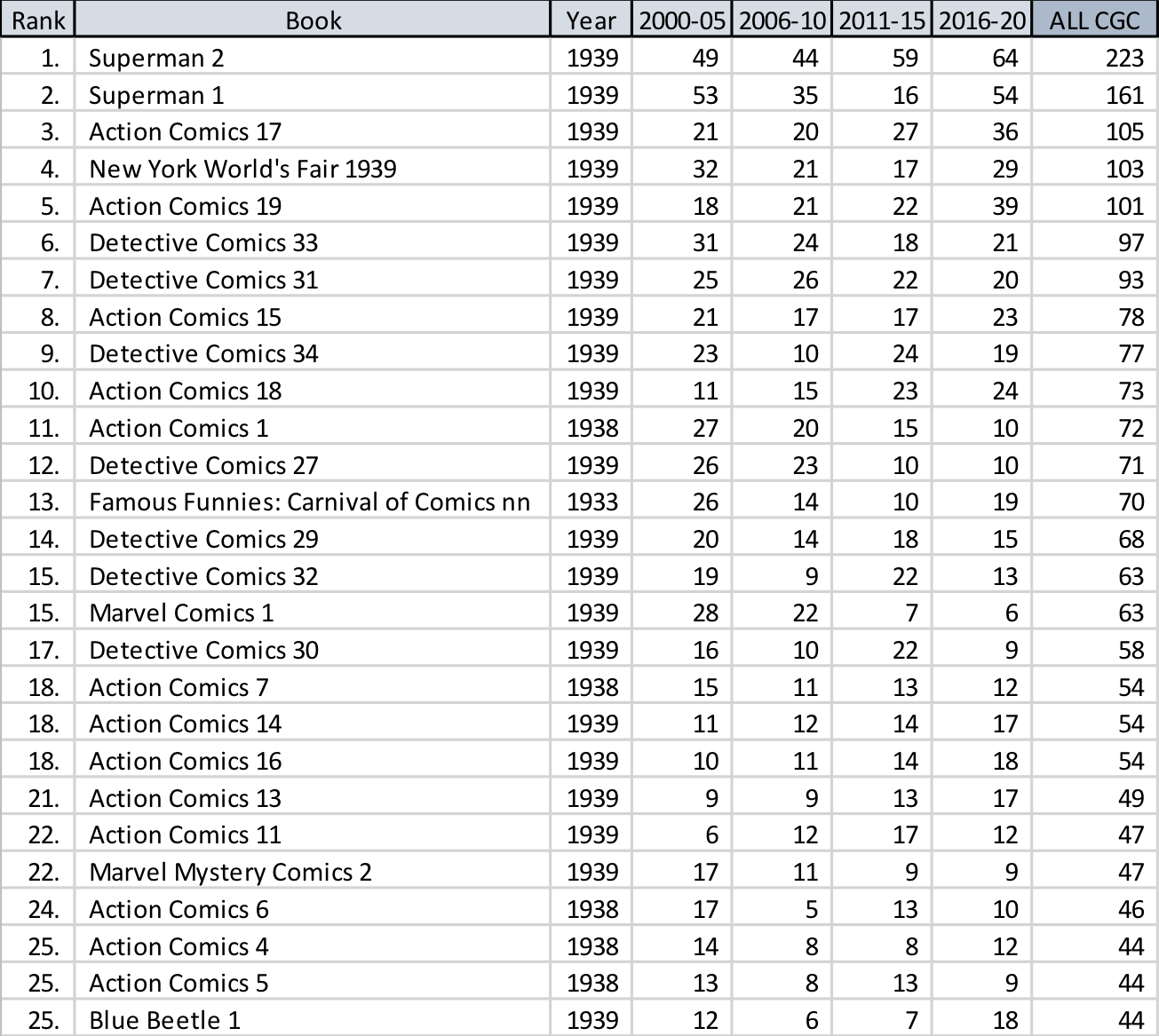
It is notable that the two most valuable comic books of all time, Action Comics #1 and Detective Comics #27 are just outside the Top 10 in CGC submissions, rather than found at the top of the list. This is an indication that the top-submitted books to CGC may reflect the survival numbers of the books, rather than a simple listing of most valuable comics. Unlike some 1930s comics in the Top 25 list, which increased the number of copies graded between 2006-10 and 2016-20, Action Comics #1 and Detective Comics #27 have decreased the number of CGC-graded copies submitted over the five-year increments. This is another indication that surviving-but-yet-ungraded copies of these books are stable or declining.
A combination of factors impact the number of CGC graded copies of 1930s comic books. First and foremost, the number of surviving comics has the greatest impact on the number of copies submitted to CGC. Because only 29 copies separate the 10th most-submitted book from the 25th most-submitted book of the 1930s, the actions of the comic book collectors have the second-greatest impact on CGC Census numbers. If a group of collectors prefers to keep their 1930s comics “unslabbed” (not professionally-graded), it could be many years before additional copies of these books are submitted to CGC.
A number of factors may have caused a collector of 1930s comic books to decide to submit to CGC in the 2016-2020 timeframe, for instance, when they had not submitted to CGC any other time. Perhaps they have decided to prepare their books for sale, perhaps they prefer CGC graded comic books to be an inheritance or for insurance purposes, or perhaps they were waiting to see if professional grading could stand the test of time and receive industry adoption. Perhaps a collector’s estate is liquidating the collection and needs professional grading to take the books to market. While all decades of comic books may be impacted by these types of collector decisions, only the 1930s and perhaps the 1940s may see significant changes by the actions of just a dozen collectors.
Other factors which can not be quantified, but do have an impact, are comic book pressing and improvements made upon comic book conditions which may result in a higher CGC grade upon resubmission. Additionally, restoration may be added or removed prior to a CGC resubmission, and it is up to the submitter to report that the book has been CGC graded in the past, so that the prior entry in the CGC Census can be removed. Not all submitters take that additional step of reporting resubmissions. As a result, the CGC Census provides a maximum number of CGC graded copies, rather than an exact number. Superman #2 (1939) shows 223 copies on the CGC Census. While there might be 213 actual CGC-graded copies in existence (if 10 copies were resubmitted without informing CGC), there are not 224 (or more) CGC-graded copies. Any errors in the CGC Census only occur in one direction, where the actual number of CGC graded copies is always equal to, or lower than, the CGC Census counts. The “ALL CGC” total does include additional copies graded between the end of 2020 and the most recent CGC Census of late-April 2021.
COMICS FROM THE 1940s – TOP 25 MOST SUBMITTED TO CGC
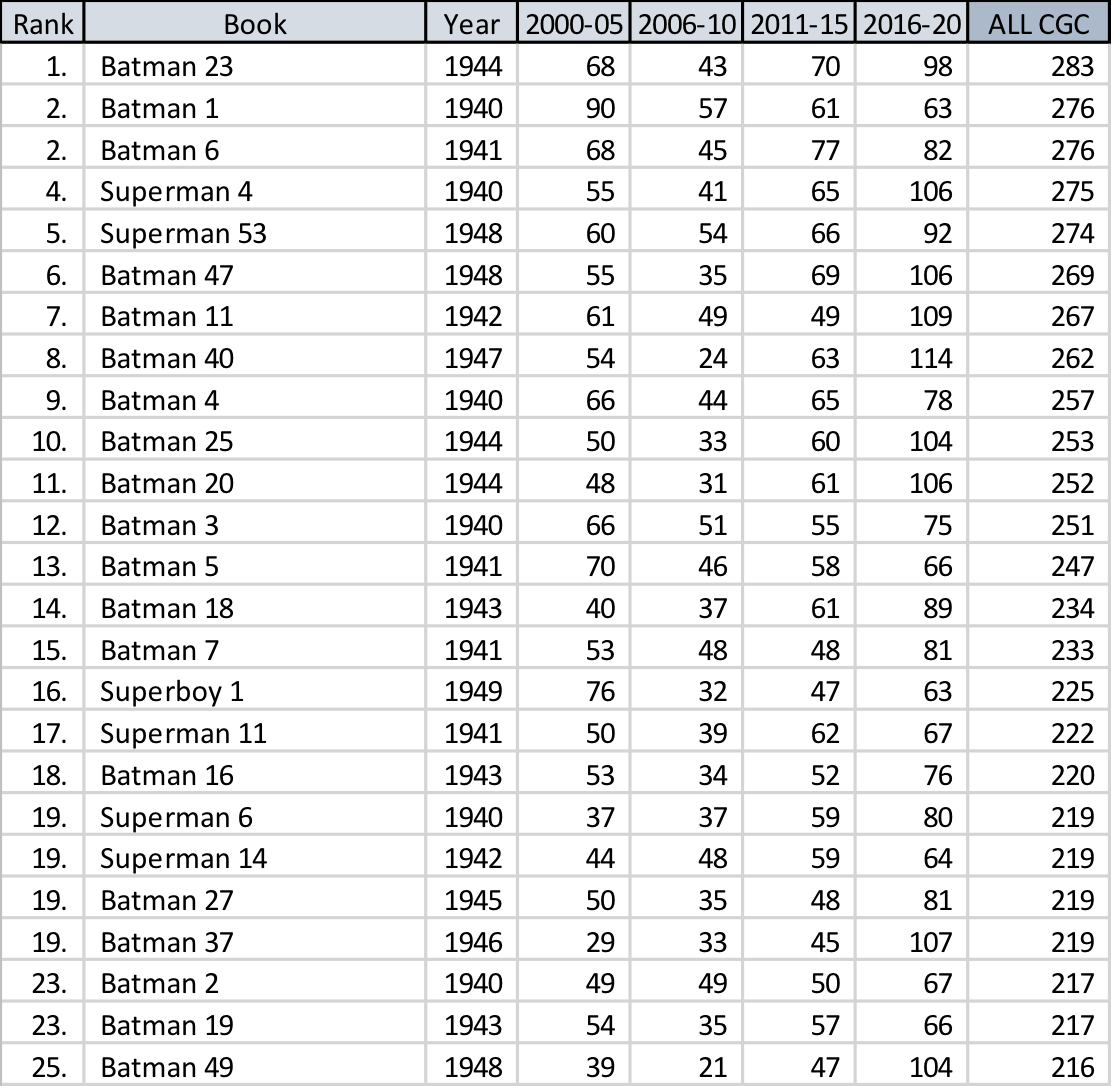
The Top 25 most-submitted 1940s comic books to CGC list is dominated by issues of Batman. While nearly 180 copies separated the most-submitted book of the 1930s from the 25th most-submitted book, the 1940s is separated by only 67 copies between 1st and 25th position on this list. Each book in this list has been submitted more than 215 times and fewer than 285 times. This is clearly a reflection of the survival rates for these comic books. That is not to say that less than 300 copies exist, but twenty years of CGC grading has accounted for less than 300 copies of each. It is unknown how many more exist, but it is reasonable to assume there are not many thousands of additional copies yet ungraded. Unlike the 1930s Top 25 list, the number of copies graded in the 2016-2020 timeframe has shown an increase for all books when compared to the 2011-2015 submissions for the same books.
COMICS FROM THE 1950s – TOP 25 MOST SUBMITTED TO CGC
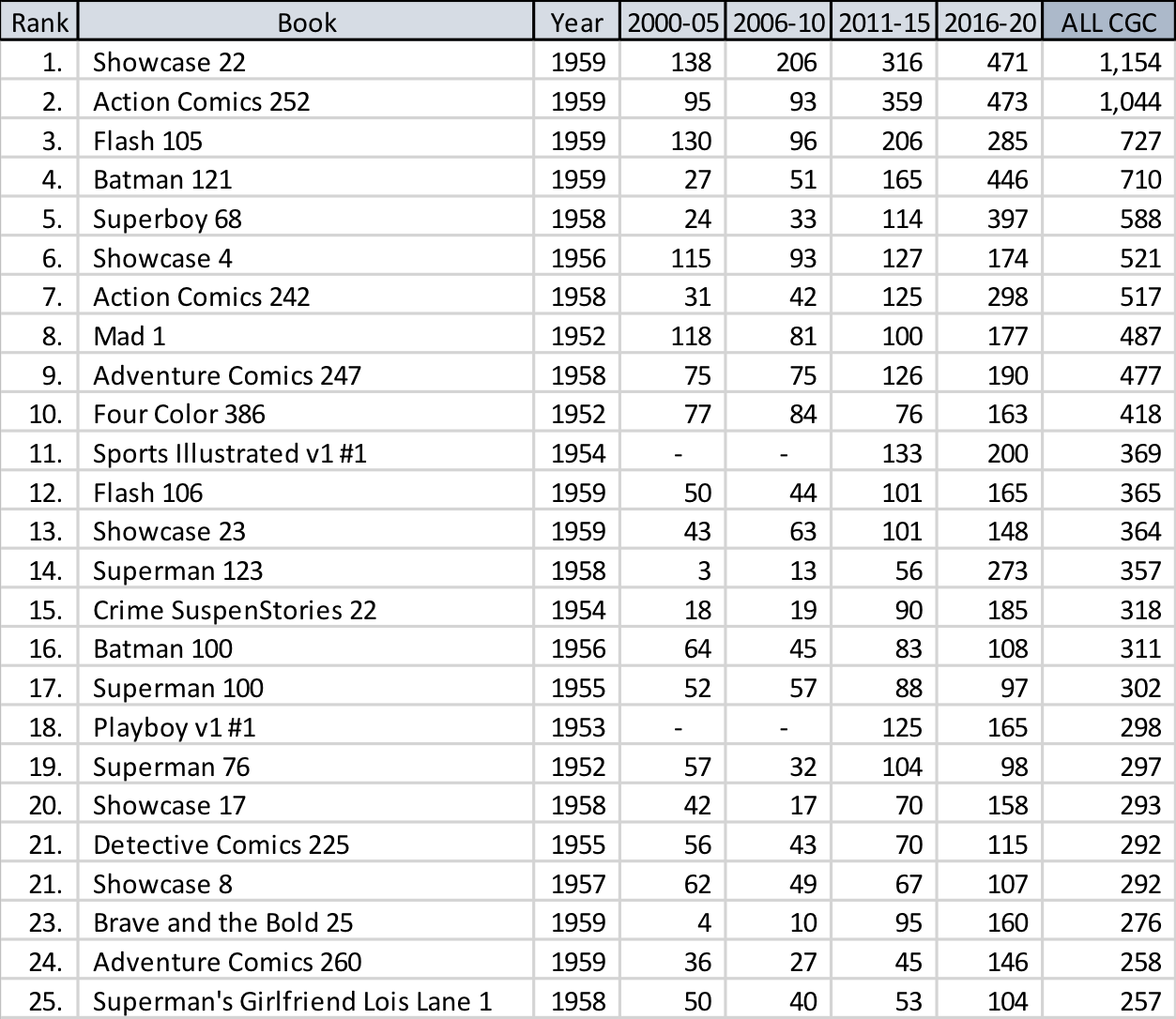
Among the Top 25 most-submitted 1950s comic books are two non-comics, Sports Illustrated v1 #1 and Playboy v1 #1. CGC did not begin grading these non-comics until September 2013, but they have quickly risen into the Top 20 for all 1950s submissions. It is noteworthy that the 1940s list did not include any comic books with more than 300 copies graded and the same is true for Batman and Superman titles through 1954. The first issues of Batman and Superman to reach 300 CGC-graded copies are issue #100 of both. Superman #123 passed 350 CGC-graded copies and it is the most-submitted issue of Superman from 1939-1959, and Batman #121 has the most CGC-graded copies for all Batman issues 1939-1959 at 710 copies. Supergirl’s first appearance in Action Comics #252 is the first to surpass 1,000 CGC-graded copies of any Superman-related title.
Showcase #4 is the most valuable comic book in the Top 25, and although Showcase #4 is significantly more valuable than Showcase #22, there are half as many CGC-graded copies of Showcase #4. Again, this is most likely a reflection of a lower supply for Showcase #4, since the title is the same as Showcase #22, and the number of CGC graded copies was very similar for both books from 2000-2005.
COMICS FROM THE 1960s – TOP 25 MOST SUBMITTED TO CGC
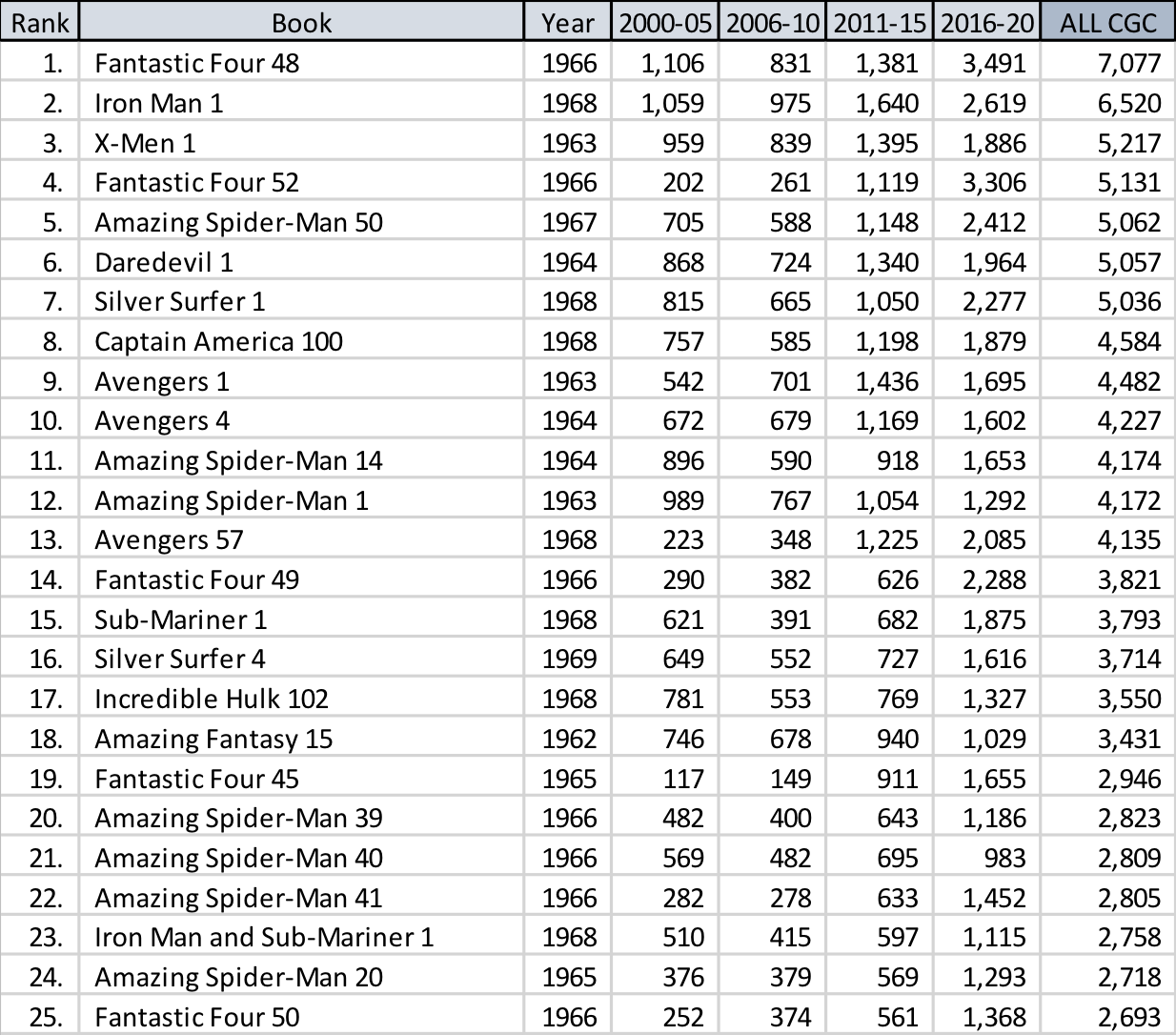
For the 1960s, the Top 25 Most-Submitted List is completely populated by Marvel Comics. The list has 7 issues from 1968. This is perhaps a significant year in comic book collecting, with the new series from Marvel resulting in higher sales at the time, higher survivability today, or both. Much like Action Comics #1 and Detective Comics #27 from the 1930s, the most valuable comic book of the 1960s, Amazing Fantasy #15, is also outside of the Top 10, in the 18th position. Another early 1960s valuable comic, Fantastic Four #1 is outside of the Top 25 entirely and is in 30th position with just over 2,500 CGC graded copies on the CGC Census. While there has been an increase of more than 1,000 copies graded between 2016-2020 for all but one of the Top 25, Fantastic Four #1 was graded only 865 times in 2016-2020. The most valuable 1960s comic books are not the most-submitted to CGC, and again, this is likely a reflection of the survival rates for those books compared to others from the same publisher just 5 to 10 years later.
COMICS FROM THE 1970s – TOP 25 MOST SUBMITTED TO CGC
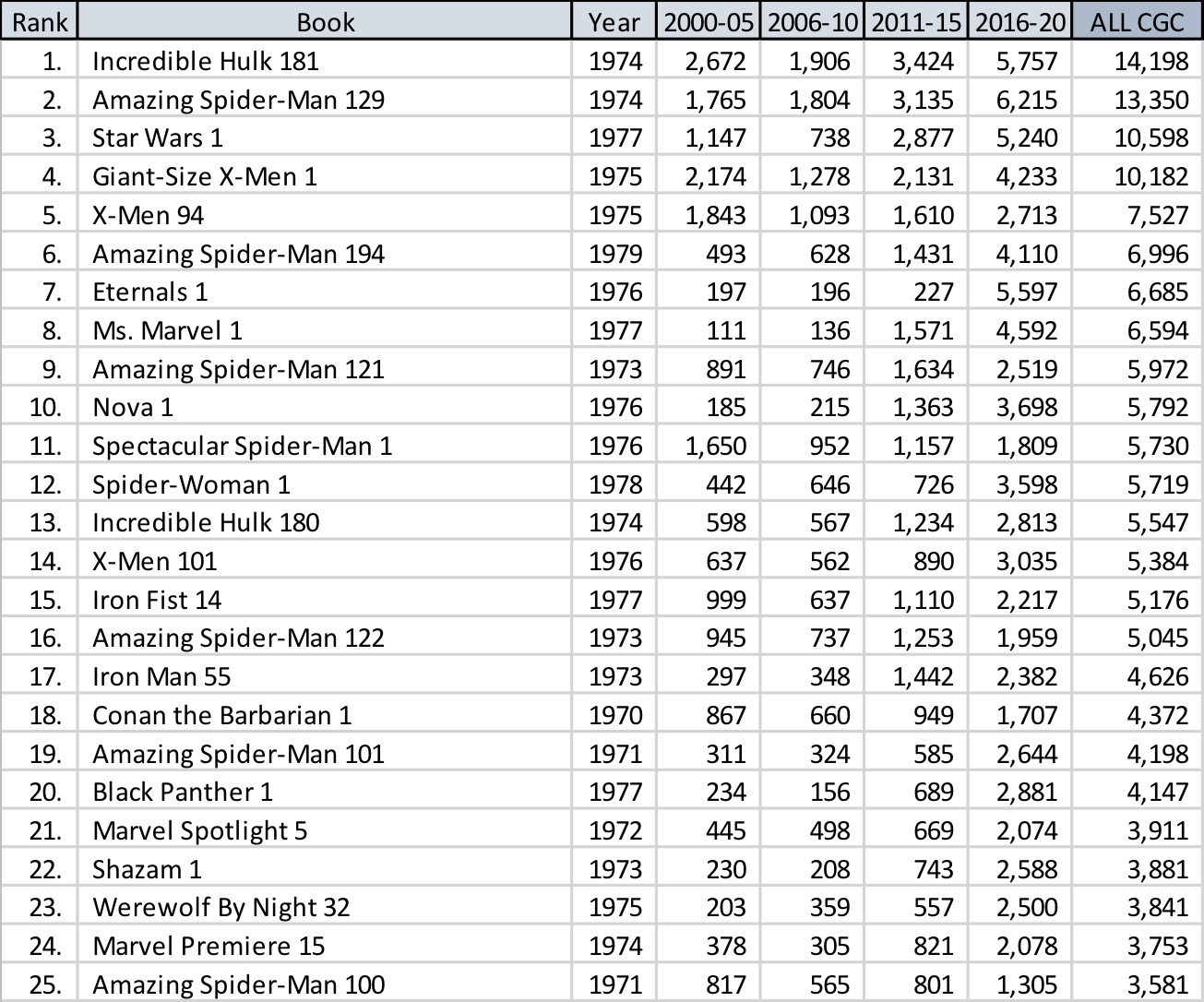
Repeating its dominance from the 1960s, the Top 25 Most Submitted Comics to CGC for the 1970s is also entirely Marvel Comics publications, with the exception of Shazam #1 (1973) from D.C. Comics. Two of the most valuable comics of the 1970s are also at the top of the list, Incredible Hulk #181 and Amazing Spider-Man #129. The 1970s is the first decade where the most valuable comics are also the most submitted to CGC.
If comic book collecting increased significantly at the end of the 1960s, it had a strong impact on the survival rates of the comics of the 1970s. There is little reason to assume that significantly fewer copies of Incredible Hulk #180 exist, when compared to Incredible Hulk #181, therefore the significant difference in the number of copies CGC graded for these two issues is attributable not to supply, but entirely to demand. Another example of demand as the primary factor in CGC submissions for the 1970s is Eternals #1 (1976) in the 7th position on the Top 25. This book has had more than 90% of its CGC-graded copies submitted since 2016, after being very low in submissions from 2000 to 2015. The upcoming Eternals movie spurred the 5,597 submissions in the past 5 years, indicating that the supply was always available, but the books were not yet in demand for more submissions to CGC.
COMICS FROM THE 1980s – TOP 25 MOST SUBMITTED TO CGC

The 1980s Top 25 shows the dominance of Amazing Spider-Man #300 (1988) for CGC submissions throughout the grading company’s history. Although Amazing Spider-Man #300 has always been very near the top of the CGC most submitted lists, the number of CGC graded copies actually doubled in the past five years, compared to the number of copies graded in the first fifteen years of CGC’s history. D.C. Comics achieves its highest Top 25 position since the 1950s on the 1980s list at 7th position for Batman: The Killing Joke (1988). It is also notable that 3 of the Top 4 for the 1980s are related to Spider-Man’s black suit costume, demonstrating the popularity of that simple design change (and eventual new character in Venom) for an established character already past its 20th year of publication.
COMICS FROM THE 1990s – TOP 25 MOST SUBMITTED TO CGC
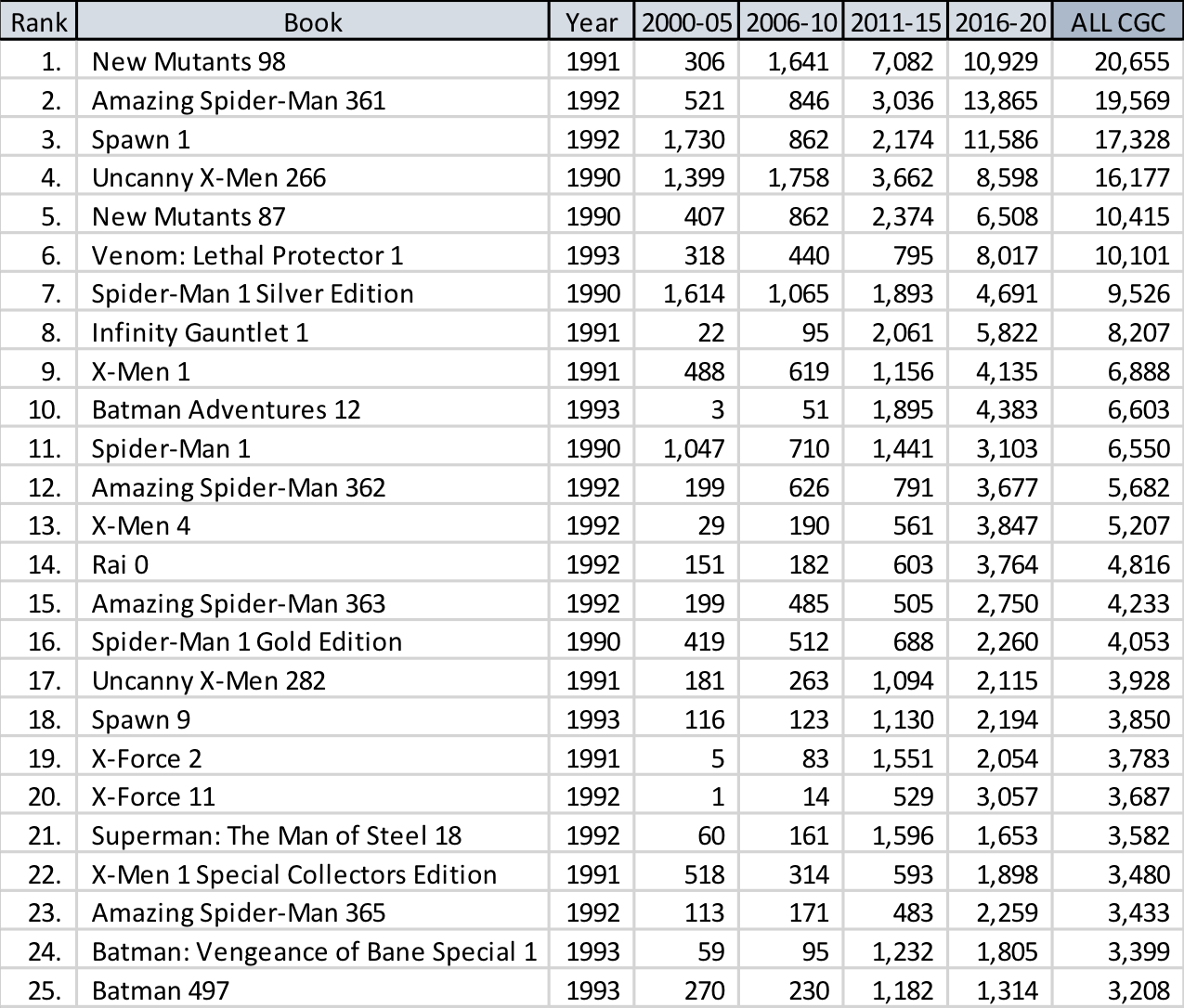
The Top 25 list for the 1990s provides the first evidence for the eventual dominance and frequency of “variant editions” in the comic book industry. Spider-Man #1 (1990) is in both 7th and 16th positions of the Top 25, represented by the Silver and Gold Editions, respectively. X-Men #1 (1991) claims 9th and 22nd positions for the regular and Special Collectors Editions of the issue. Sudden popularity is easy to recognize in the Top 25 for the 1990s, with 7 books in the Top 25 having 60 CGC graded copies (or fewer) from 2000-2005 and more than 3,300 graded since that time. Batman Adventures #12 (1993) had fewer than 60 CGC graded copies from 2000 to 2010 but is now in 10th place overall with 6,603. More than 99% of the CGC graded copies of Batman Adventures #12 were graded in the last 10 years.
The only non-Marvel, non-D.C. comic book in the Top 3 any of the decade Top 25 lists is Spawn #1 (1992) from Image comics. In many ways, Spawn #1 reflects the popularity for Spider-Man artist Todd McFarlane as much as it is an indication of a third publisher to compete with Marvel and D.C. The much greater dominance of D.C. Comics from 1930s to 1950s and Marvel Comics from 1960s to 1980s can not be overstated. Unlike the sudden dominance of Marvel in the 1960s, only three non-Marvel, non-D.C. comics make the Top 25 for the 1990s, two issues of Spawn, and Rai #0 (1992) from Valiant.
COMICS FROM THE 2000s – TOP 25 MOST SUBMITTED TO CGC
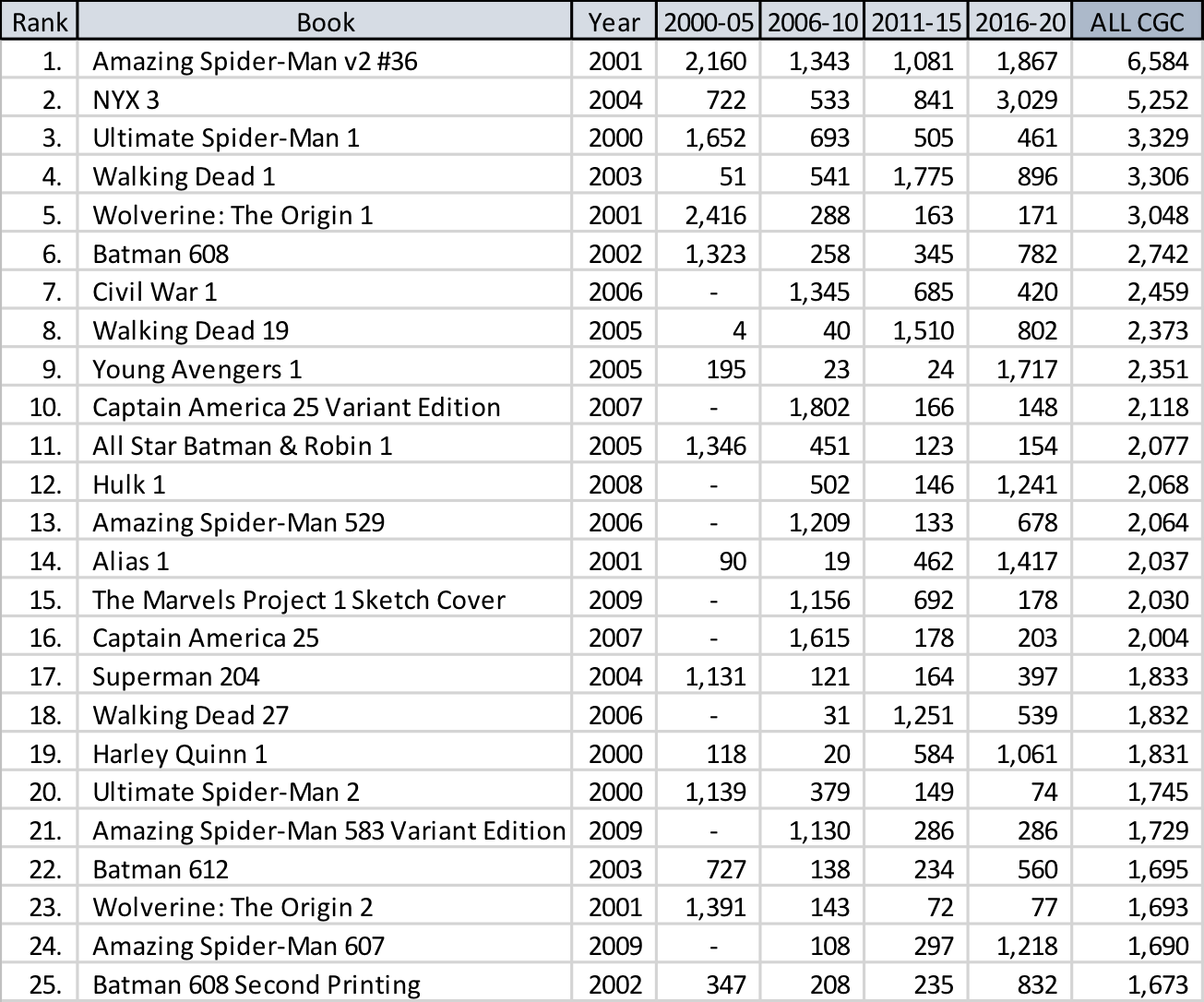
The Top 25 list for comic books from the 2000s (2000 to 2009) shows a mixture of initial popularity, recent interest, and long-term significance. Issues of Walking Dead had almost no presence in the CGC Census prior to 2011, but there are three issues of Walking Dead in the Top 20 of 2000s comics as of the most recent CGC Census. Other comics in the Top 25 reflect an initial popularity for CGC submissions in the decade and little activity since, particularly for second issues (#2) of new titles at the time. Ultimate Spider-Man #2 (2000) and Wolverine: The Origin #2 (2001) had more than a thousand copies graded between 2000-2005, and fewer than 80 copies graded between 2016-2020. Amazing Spider-Man v2 #36 (2001) has maintained interest for 20 years since the events of 9/11 in 2001 and holds the top position in the list.
COMICS FROM THE 2010s – TOP 25 MOST SUBMITTED TO CGC
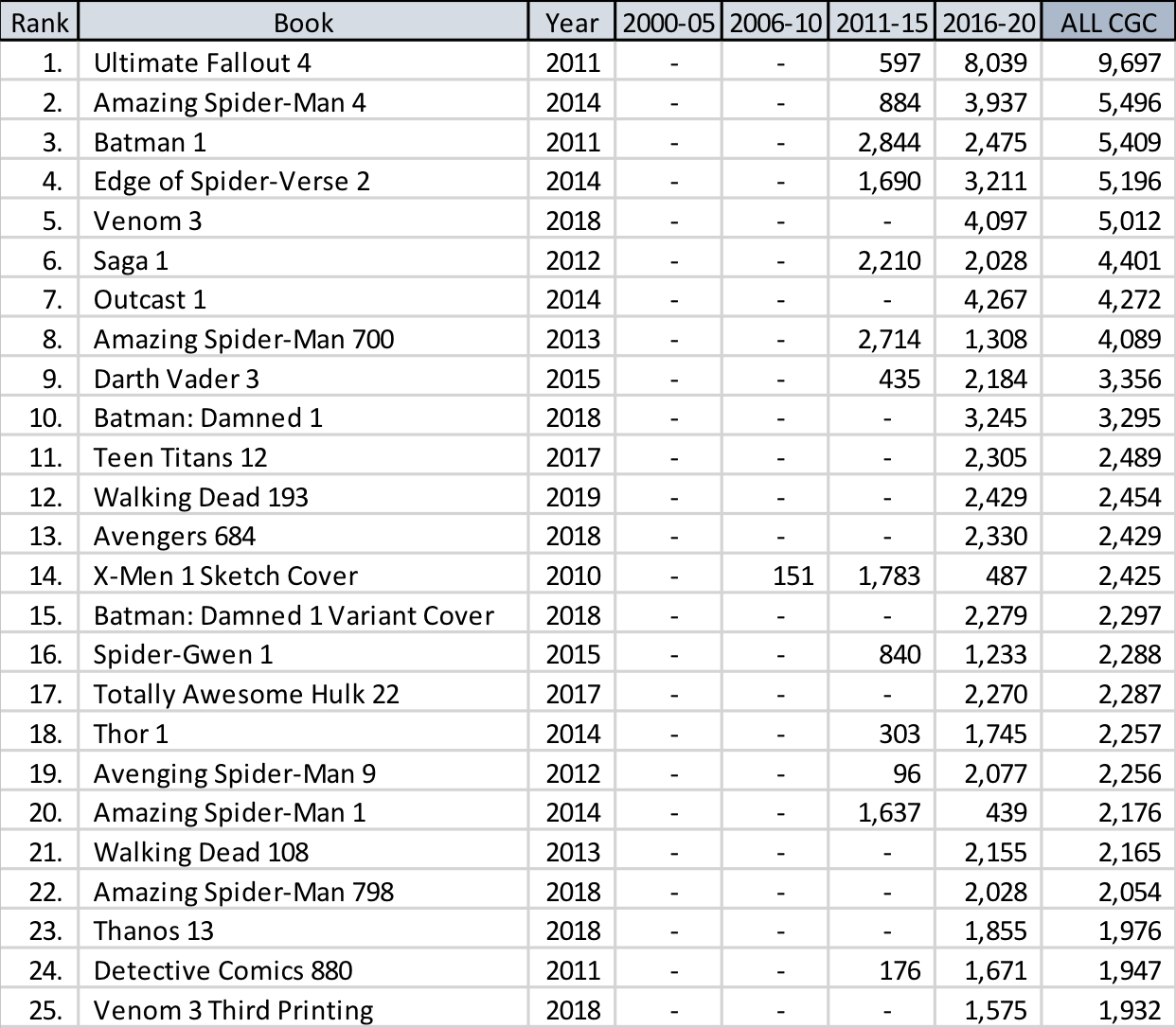
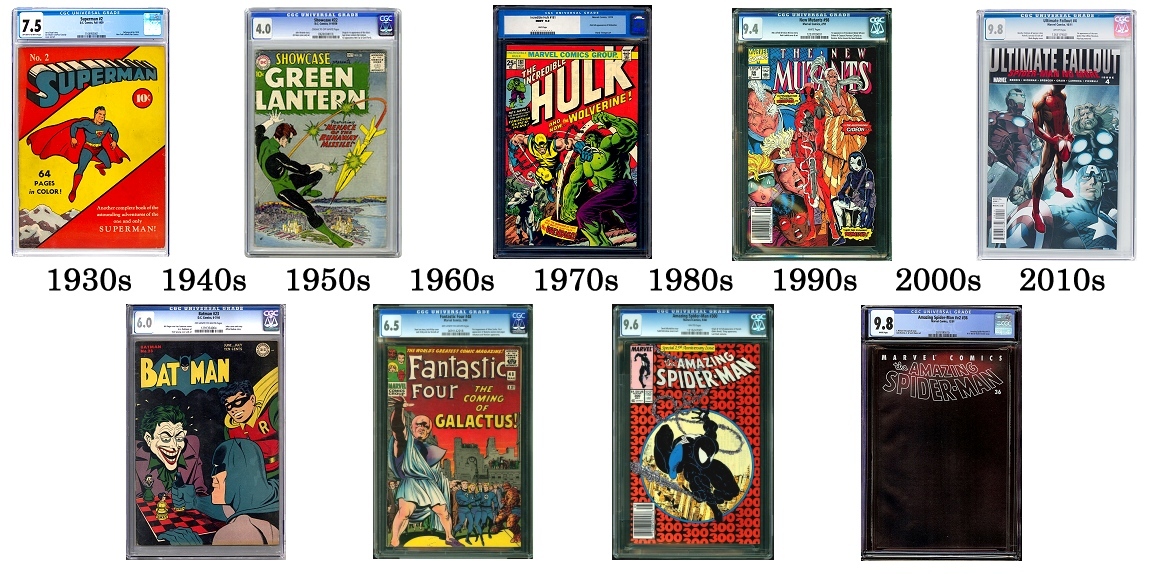
While it makes sense that none of the comic books from the 2010s were graded between 2000 and 2009, this list does provide a glimpse into the immediate popularity (or not) for the Top 25 of the 2010s. Most notable is Ultimate Fallout #4, which is in the 1st position currently, was behind 8 of the other Top 25 issues following 2015, four years after its release. In fact, Ultimate Fallout #4 was 29th at the end of 2015, and would not have made the Top 25 list at that time. In contrast, Batman #1 (2011) and Saga #1 (2012) have maintained their rates of submission through the entirety of their history.
CONCLUSION
The Top 25 Most Submitted Comic Books to CGC by decade presented in this article may not provide any surprises for collectors, but the separation of the numbers of copies CGC graded in the five-year timeframes allows for a view into CGC submission frequency over time. Some books at the top of the CGC submissions lists have been popular since the beginning of CGC grading. Other books near the top of these lists have seen their popularity wane since earlier years of CGC, and yet other books are recent additions to their decade’s Top 25 years after publication. The prior article in this series focused on the Top 25 Overall submissions, prohibiting any pre-1966 comic books from being discussed due to their lower numbers. This article gives each decade its due, and although each decade seems to be dominated by one publisher or another, the hope is that collectors will find something of interest related to their own collections.
About the Author
 |
Greg Holland has collected comic books for over 30 years and has been the administrator of the CGC Census Analysis website since 2003, currently located at CGCdata.com. He is the 1999 founder of the ValiantComics.com website and the 2004 ValiantFans.com message board. Dr. Holland holds a Ph.D. in information quality from the University of Arkansas at Little Rock and has held data science positions as research director, analyst, and administrator for government, corporations, and university. Active on the CGC Forums as ‘valiantman’ since 2002, he is also a 15+ year advisor to the Overstreet Comic Book Price Guide and contributor to later editions of the Standard Catalog of Comic Books. Greg resides in Arkansas, USA, with his wife of 23 years and their daughter. |
Related news
24 Oct 2022
Canadian Price Variants (CPVs) and GPAnalysis.com Recorded Sales
With Canadian Price Variants recorded in GPAnalysis.com for decades, what can the data tell us about rarity and value when comparing against direct editions?
Read more26 May 2022
CGC Census - A Game for the Thousandth Collector
Imagine a game where 1,000 lucky comic collectors are awarded the best available copies of comic books from the CGC Census. Where would ticket #1,000 be for the earliest appearances of favorite characters? Some winning books may surprise you.
Read more